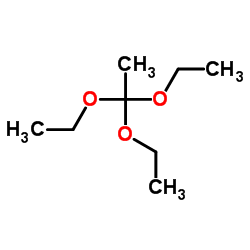Stains-All

Stains-All structure
|
Common Name | Stains-All | ||
|---|---|---|---|---|
| CAS Number | 7423-31-6 | Molecular Weight | 559.58300 | |
| Density | N/A | Boiling Point | N/A | |
| Molecular Formula | C30H27BrN2S2 | Melting Point | N/A | |
| MSDS | Chinese USA | Flash Point | N/A | |
Use of Stains-AllStains-All is a cationic carbocyanine dye. |
| Name | carbocyanin DBTC |
|---|---|
| Synonym | More Synonyms |
| Description | Stains-All is a cationic carbocyanine dye. |
|---|---|
| Related Catalog | |
| In Vitro | Almost all of the proteins found in skeletal muscle extracts, including the Ca2++Mg2+-ATPase and the 53,000-Da glycoprotein of the sarcoplasmic reticulum, are stained red or pink with Stains-all. Calsequestrin, the 1 60,000-Da glycoprotein, and 170,000-Da protein are stained blue with Stains-all. The ratio of Stains-all staining (measured at 615 nm) to that of Coomassie blue staining (measured at 575 nm) is 1.3 for calsequestrin, 2.0 for calmodulin, 1.4 for troponin C, and 2.2 for S-100. Therefore, in addition to differentially staining these Ca2+-binding proteins blue, Stains-all is a more sensitive stain for these Ca2+-binding proteins than is Coomassie blue[1]. |
| Kinase Assay | Slab gels are fixed overnight with 25% isopropyl alcohol and washed exhaustively in 25% isopropyl alcohol to remove SDS. The gels are then stained in the dark for at least 48 h with 0.0025% Stains-all, 25% isopropyl alcohol, 7.5% formamide, and 30 mM Tris base, pH 8.8. The interaction of Stains-all with various Ca2+-binding proteins is also studied in aqueous solution. The standard solution contains 10 mM Tris base, pH 8.8, 0.001% Stains-all, and 0.1% formamide. Ca2+-binding proteins (0.5 to 12 μg) are added to 1.0 mL of solution and then incubated at room temperature in the dark for 30 min. The absorbance at 600 nm is then measured against a control solution, containing no protein, using a spectrophotometer[1]. |
| References |
| Molecular Formula | C30H27BrN2S2 |
|---|---|
| Molecular Weight | 559.58300 |
| Exact Mass | 558.08000 |
| PSA | 65.29000 |
| LogP | 4.72030 |
| Storage condition | 2-8°C |
| Personal Protective Equipment | Eyeshields;Gloves;type N95 (US);type P1 (EN143) respirator filter |
|---|---|
| Safety Phrases | S24/25 |
| RIDADR | NONH for all modes of transport |
| WGK Germany | 3 |
|
~% 
Stains-All CAS#:7423-31-6 |
| Literature: Journal of the American Chemical Society, , vol. 57, p. 547,550 Journal of the Science of Food and Agriculture, , vol. 8, p. 432,434 |
|
~% 
Stains-All CAS#:7423-31-6 |
| Literature: US2486173 , ; |
|
Rotenone inhibits primary murine myotube formation via Raf-1 and ROCK2.
Biochim. Biophys. Acta 1853 , 1606-14, (2015) Rotenone (ROT) is a widely used inhibitor of complex I (CI), the first complex of the mitochondrial oxidative phosphorylation (OXPHOS) system. However, particularly at high concentrations ROT was also... |
|
|
De novo design of an RNA tile that self-assembles into a homo-octameric nanoprism.
Nat. Commun. 6 , 5724, (2015) Rational, de novo design of RNA nanostructures can potentially integrate a wide array of structural and functional diversities. Such nanostructures have great promises in biomedical applications. Desp... |
|
|
Transcription of the Streptococcus pyogenes hyaluronic acid capsule biosynthesis operon is regulated by previously unknown upstream elements.
Infect. Immun. 82(12) , 5293-307, (2014) The important human pathogen Streptococcus pyogenes (group A Streptococcus [GAS]) produces a hyaluronic acid (HA) capsule that plays critical roles in immune evasion. Previous studies showed that the ... |
| 3,3'-DIETHYL-9-METHYL-4,5,4',5'-DIBENZOTHIACORBOCYANINE |
| EINECS 231-047-7 |
| DBTC |
| 3,3'-DIETHYL-9-METHYL-4,5,4',5'-DIBENZOTHIACARBOCYANINE |
| STAINS-ALL |
| 4,5,4',5'-dibenzo-3,3'-diethyl-9-methylthiocarbocyanine bromide |
| MFCD00078788 |
| Dibenzo-3,3'-diethyl-9-methylthiacarbocyanine-bromide |
| CARBOCYANIN DBTC |
![1-ethyl-2-methylnaphtho[1,2-d]thiazolium toluene-p-sulphonate structure](https://image.chemsrc.com/caspic/291/42952-29-4.png)


![1-(1-ethyl-1H-naphtho[1,2-d]thiazol-2-ylidene)-propane-2-thione structure](https://image.chemsrc.com/caspic/398/68162-26-5.png)